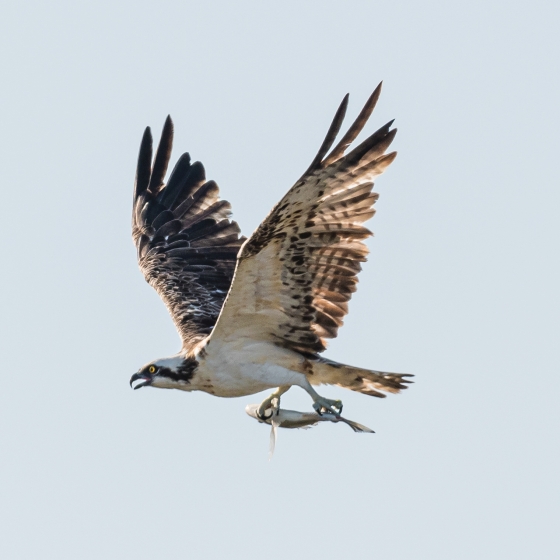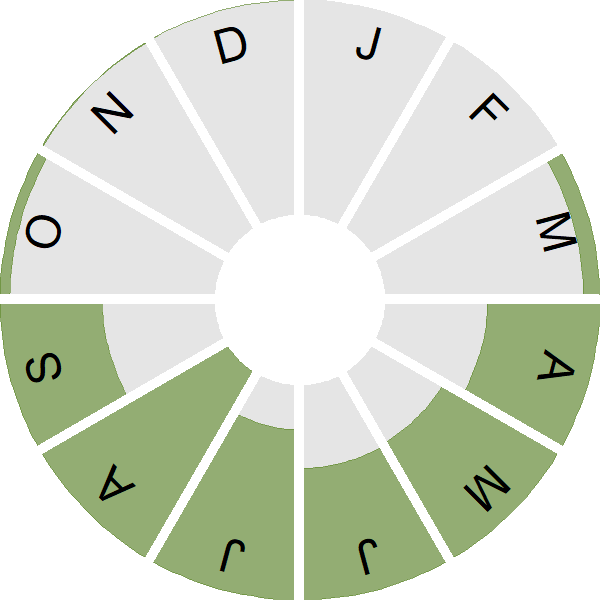Osprey

Introduction
Feeding almost entirely on fish, this large brown and white bird of prey is a summer visitor to Britain, breeding at sites across Scotland and the north of England.
The first birds can arrive back as early as late February but the BirdTrack reporting rate graphs show the main arrival occurs in early April. In the early 1900s, the Osprey became extinct as a breeding bird in Britain but in 1955 a single pair set up home in Scotland and the Osprey was back. Thanks to a successful reintroduction programme Ospreys now also breed in both England and Wales.
Tracking studies have revealed the routes used by migrating Ospreys as they travel to and from their wintering grounds in West Africa.

Key Stats
Identification
Songs and Calls
Call:
Flight call:
Begging call:
Status and Trends
Conservation Status
Population Change
Ospreys became more or less extinct in the early twentieth century (Dennis 2008) but numbers have increased substantially in the UK since the 1950s when successful breeding began at Loch Garten. The latest submissions to the RBBP give a mean figure of 242 breeding pairs over the five-year period 2015–2019 (Eaton et al. 2021). This is considered to be an under-estimate of the true population as coverage is no longer complete in the core part of the range in Scotland. The range of the species across the UK has also expanded, mostly as a result of successful reintroduction schemes.
Distribution
The Osprey's main breeding range is the straths and lowlands of eastern and central Highlands of Scotland, plus Tayside and central Scotland. Through introductions and ongoing colonisation there are now breeding birds at several sites in southern England and Wales, and many summering birds associated with a number of large wetland complexes.
Occupied 10-km squares in UK
2007/08–10/11
or view it on Bird Atlas Mapstore.
2008–11
or view it on Bird Atlas Mapstore.
European Distribution Map
Distribution Change
Change in occupied 10-km squares in the UK
from 1981–84 to 2007–11
or view it on Bird Atlas Mapstore.
from 1968–72 to 2008–11
or view it on Bird Atlas Mapstore.
Seasonality
Ospreys are one of the earliest summer visitors, some individuals arriving as early as late February, though most don't arrive until April. Some individuals linger well into autumn.
Weekly pattern of occurrence
The graph shows when the species is present in the UK, with taller bars indicating a higher likelihood of encountering the species in appropriate regions and habitats.

Movement
Britain & Ireland movement
Foreign locations of birds ringed or recovered in Britain & Ireland
Dots show the foreign destinations of birds ringed in Britain & Ireland, and the origins of birds ringed overseas that were subsequently recaptured, resighted or found dead in Britain & Ireland. Dot colours indicate the time of year that the species was present at the location.
- Winter (Nov-Feb)
- Spring (Mar-Apr)
- Summer (May-Jul)
- Autumn (Aug-Oct)

European movements
EuroBirdPortal uses birdwatcher's records, such as those logged in BirdTrack to map the flows of birds as they arrive and depart Europe. See maps for this species here.
The Eurasian-African Migration Atlas shows movements of individual birds ringed or recovered in Europe. See maps for this species here.
Biology
Productivity and Nesting
Nesting timing
Egg measurements
Clutch Size
Survival and Longevity
Survival is shown as the proportion of birds surviving from one year to the next and is derived from bird ringing data. It can also be used to estimate how long birds typically live.
View number ringed each year in the Online Ringing Report.
Lifespan
Survival of adults
Survival of juveniles
Biometrics
Wing length and body weights are from live birds (source).
Ring Size
Classification, names and codes
Classification and Codes
- Order: Accipitriformes
- Family: Pandionidae
- Scientific name: Pandion haliaetus
- Authority: Linnaeus, 1758
- BTO 2-letter code: OP
- BTO 5-letter code: OSPRE
- Euring code number: 3010
Alternate species names
- Catalan: àguila pescadora
- Czech: orlovec rícní
- Danish: Fiskeørn
- Dutch: Visarend
- Estonian: kalakotkas
- Finnish: sääksi (kalasääski)
- French: Balbuzard pêcheur
- Gaelic: Iolaire-iasgaich
- German: Fischadler
- Hungarian: halászsas
- Icelandic: Gjóður
- Irish: Coirneach
- Italian: Falco pescatore
- Latvian: zivjerglis
- Lithuanian: erelis žuvininkas
- Norwegian: Fiskeørn
- Polish: rybolów
- Portuguese: águia-pescadora / águia-pesqueira
- Slovak: kršiak rybár
- Slovenian: ribji orel
- Spanish: Águila pescadora
- Swedish: fiskgjuse
- Welsh: Gwalch Pysgod
- English folkname(s): Bald Buzzard
Research
Causes of Change and Solutions
Causes of change
The effective extinction of Osprey as a UK breeding species in the early twentieth century was caused by persecution and egg-collecting (Dennis 2008). The increases since the 1950s have been driven by increased protection and intensive conservation action, including nest-guarding and a reintroduction programme in England (Schmidt-Rothmund et al. 2014).
More Evidence
More evidence from Conservation Evidence.com
Partners
Citing BirdFacts
If you wish to cite particular content in this page (e.g. a specific value) it is best to use the original sources as linked in the page. For a more general citation of the whole page please use: BTO (20XX) BirdFacts Species: profiles of birds occurring in the United Kingdom. BTO, Thetford (www.bto.org/birdfacts, accessed on xx/xx/xxxx).

